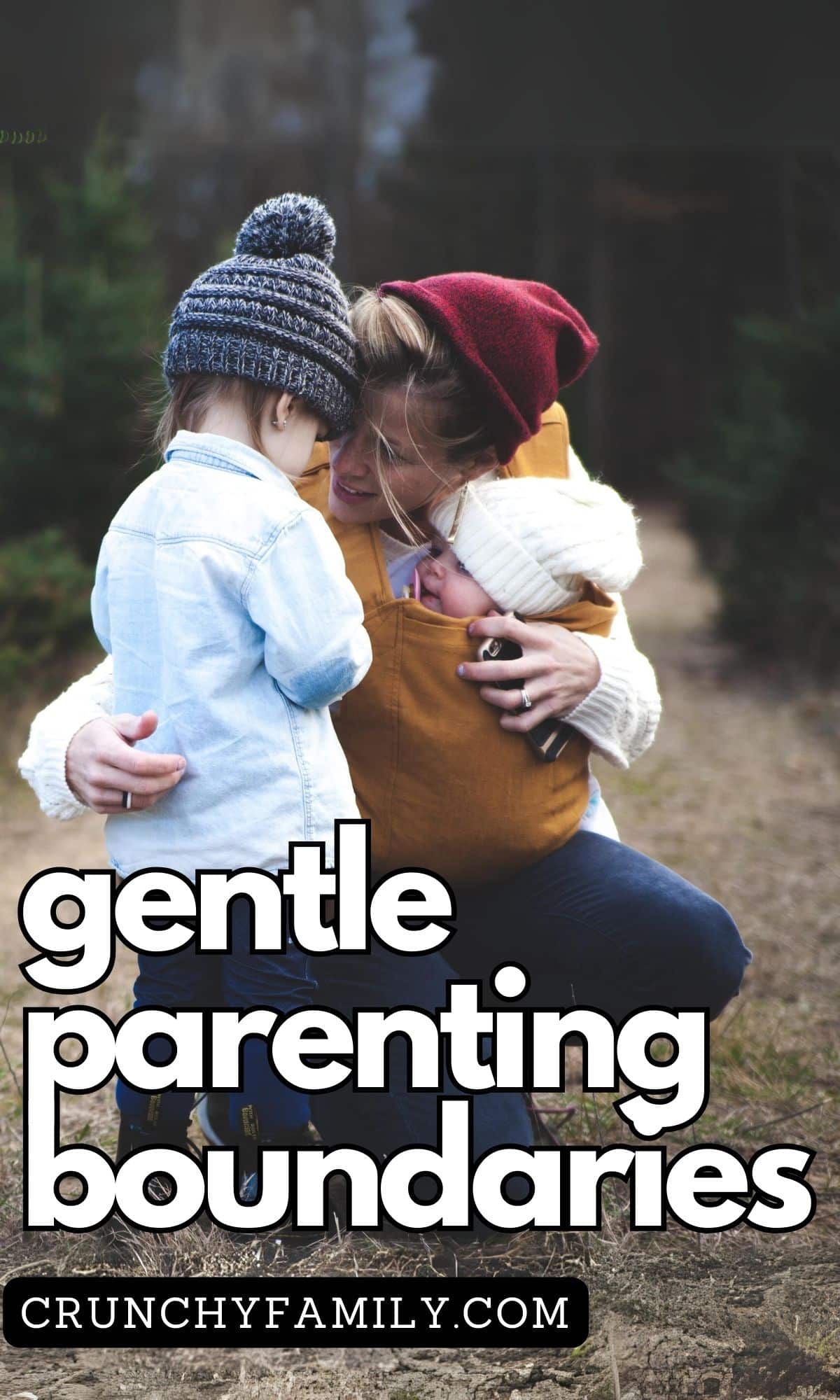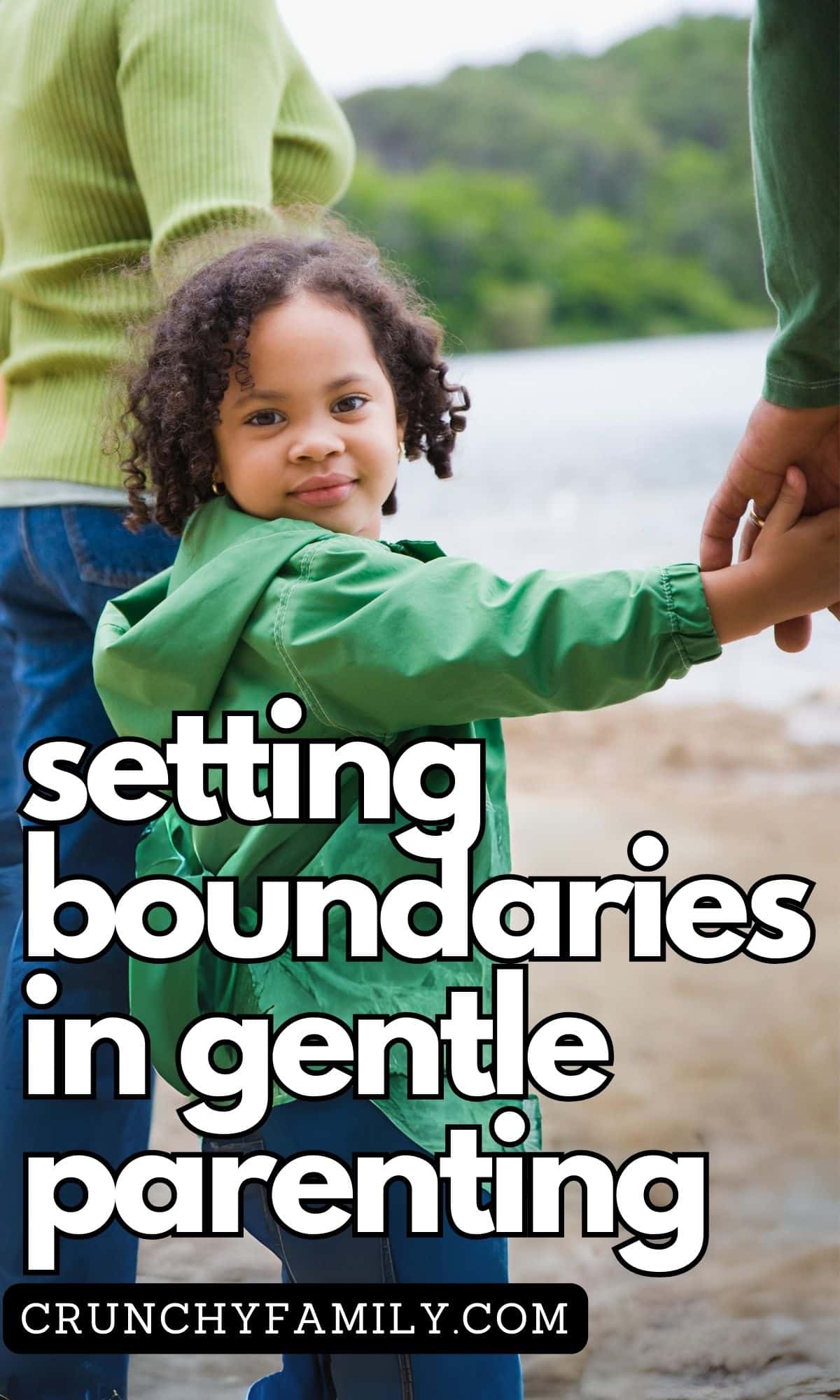Gentle parenting is all about love and respect, but thst doesn’t mean permissive parenting without discipling our children. So let’s get into the topic of gentle parenting boundaries and gentle discipline.
Gentle discipline is an important part of this parenting method and is a philosophy where discipline is woven with love and respect, guiding children through their journey of growth without breaking their spirit.
So, let’s explore how this approach not only respects our little ones’ individuality but also fosters a healthy, positive family environment, and look at why nurturing love and respect in discipline matters, and later on in the post we will look at some gentle parenting examples of how to set boudaries kindly and gentley but effectively in different types of situations.

Understanding Child Development for Gentle Parenting Discipline
To practice gentle parenting effectively, we need to start by setting age-appropriate expectations. Every child is unique, and recognizing their individual needs and personalities plays a critical role. It’s essential to understand how discipline strategies impact child development, helping us tailor our approach to suit our children best as they grow and flourish.
We shouldn’t set expectations that are not developmentally appropriate for our child, as this leads to frustration on both sides.

In addition to setting age-appropriate expectations, it’s helpful to look into how each developmental stage influences behavior. Understanding these stages helps us appreciate why children may act out or struggle with certain boundaries.
For instance, toddlers often test limits as a natural part of exploring their world. By appreciating these developmental nuances, parents can tailor their discipline strategies to be both effective and empathetic, fostering a secure environment where children feel understood.
Understanding this and being compassionate to our child’s needs developmentally makes a big difference not only for gentle parents, but is helpful with all parenting styles.
Setting Boundaries with Love
Boundaries are vital in any relationship, more so in the delicate bond between parent and child. Establishing clear and consistent limits with kindness allows children to feel secure and valued.
When we communicate a boundary and set our expectations with love, we affirm that while rules are necessary, they are set within a safe and loving framework. This approach nurtures the child’s autonomy, respecting them as individuals in their own right.
While establishing clear limits is fundamental, integrating these boundaries into daily routines can also promote a smoother family dynamic.
For example, involving children in the creation of household rules can make them feel invested and more likely to follow these guidelines. This inclusive approach not only reinforces boundaries with love but also nurtures a spirit of teamwork and family unity.

Setting Boundaries with Respect
In the gentle parenting style, respect is key. This means we steer clear of punitive measures that harm the child’s dignity. Instead, we use positive reinforcement to encourage desired behaviors and foster collaboration and cooperation. This not only teaches children to respect others but also to value themselves and their community.
Beyond avoiding punitive measures, setting boundaries with respect includes educating children about the reasons behind rules. When children understand why certain behaviors are expected, they’re more likely to comply willingly rather than feeling controlled or restricted.
This educational approach respects their intelligence and capacity for understanding, further reinforcing the respectful nature of gentle parenting.
Tools and Techniques for Gentle Discipline
Effective gentle discipline is rich with strategies like active listening, which ensures that children feel heard and valued. Empathy and understanding go a long way in addressing the root causes of behaviors rather than just the symptoms.
Techniques such as redirecting behavior and providing choices empower children to make better decisions independently, fostering a sense of responsibility.
Adding to the effective techniques already mentioned, problem-solving together is another powerful tool in gentle discipline. When faced with behavioral issues, collaborating with your child to find solutions not only addresses the immediate problem but also teaches critical thinking and conflict resolution skills. This method ensures discipline becomes a learning process rather than a punitive experience.

Consistency and Follow-Through
Consistency is the backbone of effective parenting, and is one of the 3 Cs of gentle parenting (connection, consistency and communication)
Maintaining consistent boundaries and implementing consequences with compassion reinforce a sense of predictability and security in a child’s world. Following through with promises shows children that they can trust and rely on us, paving the way for a stable relationship.
Highlighting the importance of routine can also enhance consistency in parenting. Routines provide a predictable structure that helps children feel safe and secure. When children know what to expect, they’re less likely to feel anxious or act out, making it easier to maintain consistent boundaries and effectively follow through with discipline.
Encouraging Positive Behavior
Everyone thrives on praise and encouragement, and children are no exception. By reinforcing good behavior, we motivate children to continue acting in desirable ways. Teaching them about emotional regulation and self-control, and celebrating their milestones, encourages them to keep improving.
In addition to praising good behavior, setting up a supportive environment that anticipates and prevents misbehavior can be very effective. This proactive approach involves arranging physical spaces, schedules, and interactions that naturally encourage desirable behavior, thus minimizing opportunities for conflict and enhancing overall harmony within the home.

Addressing Challenges with Gentleness
Parenting is not without its challenges. Handling tantrums, defiance, and aggressive behavior with gentleness and patience can be tough, but it’s crucial for building a supportive environment where children can learn to manage their emotions healthily.
When challenges arise, it’s also beneficial to adjust our own expectations and strategies as parents. Sometimes, what we perceive as defiance or a tantrum might actually be a sign of unmet needs or overwhelming emotions. By staying flexible and responsive to our child’s cues, we can address the root causes of challenging behaviors more effectively, with compassion and understanding.
Modeling Respectful Discipline
As parents, we are our children’s first heroes. Being a positive role model, demonstrating empathy, and building trust are foundational in gentle parenting. This not only teaches children by example but also deepens our connection with them, making discipline a shared journey rather than a battlefield.
Gentle discipline is a powerful, respectful approach that strengthens the bond between parent and child. It’s built on the pillars of love and respect, empowering us as parents to lead by example.
To truly model respectful discipline, we need to demonstrate consistency in our own behavior. Children are keen observers and often mimic adult actions. When they see us handling our mistakes with accountability and grace, they learn to do the same.
This modeling extends beyond discipline into all aspects of daily life, providing children with a consistent, reliable framework for their own behavior.

Examples of Gentle Parenting Boundaries
Gentle parenting emphasizes respectful and loving ways to set boundaries. Here are some practical examples of gentle parenting boundaries that blend firmness with kindness.
If you’re wondering how to do gentle parenting or how to start gentle parenting, sometimes it’s just as simple as taking it one moment at a time and trying to do better in that particular situation, incorporating gentle parenting techniques that feel right for that moment – and soon, gentle respectful parenting will just be your default.

- Use of Positive Language: Instead of saying, “Don’t run inside the house,” you could say, “Please walk inside the house.” This shifts the focus from what they can’t do to what they can do, framed in a positive light. Related: 15 Key Phrases to Embrace and Avoid with Your Child
- Offering Choices: When it’s time to clean up toys, instead of a flat directive, offer a choice: “Would you like to start by putting away the blocks or the dolls?” This gives children a sense of control within the boundaries you’ve set.
- Clear Expectations: Before visiting a store, explain what behavior you expect: “We need to stay calm in the store and use our indoor voices. Let’s pick one treat you’d like to buy before we go in.” Setting expectations beforehand can prevent misbehavior.
- Time-In Instead of Time-Out: If a child is having a hard time, instead of sending them away to time-out, you can use a time-in. This means sitting with them quietly, perhaps cuddling or reading a book together until they feel better. It teaches them to manage their emotions with support. Related: 6 Gentle Parenting Alternatives to Time Out
- Natural Consequences: If a child throws food on the floor, a natural consequence is that they help clean it up. This teaches responsibility for their actions in a direct, but non-punitive way.
- Validating Feelings: When setting a boundary, acknowledge their feelings, “I see that you’re upset because we have to leave the playground now, but it’s time for dinner. We can come back tomorrow.” This validation can make the transition easier and shows respect for their emotions.
- Consistent Bedtime Routine: Establish a consistent bedtime routine that involves calming activities like reading a book or talking about the day. This helps set the expectation that nighttime is for winding down, making it easier to enforce bedtime without resistance. Related: 12 Effective Natural Remedies for Insomnia in a Child
- Technology Use: Set clear, agreed-upon limits for screen time. You might say, “You can watch one episode of your show or spend 30 minutes on the tablet, and then it’s time to turn it off.” Engage them in a discussion about why these limits are beneficial.
- Respecting Personal Space: Teach children that they have the right to their own personal space and that they need to respect others’ as well. For example, “If your sister says no to playing, we need to respect her wishes and give her some space.”
- Collaborative Problem Solving: When conflicts arise, involve your child in the solution. “It seems like you and your brother both want to play with the same toy. How can we make this work so you both have fun?”
As we wrap up, remember, gentle parenting isn’t about having a perfect child or being a perfect parent. It’s about guiding our children with love, respecting their individuality, and walking alongside them in their life’s journey.
More Gentle Parenting
- Other terms for gentle parenting
- Common Gentle Parenting Myths
- Gentle Parenting alternatives to time out
- How to discipline with gentle parenting
- Phrases to avoid with your child
- Natural remedies to help with sleep in kids

3 thoughts on “Setting Boundaries in Gentle Parenting”